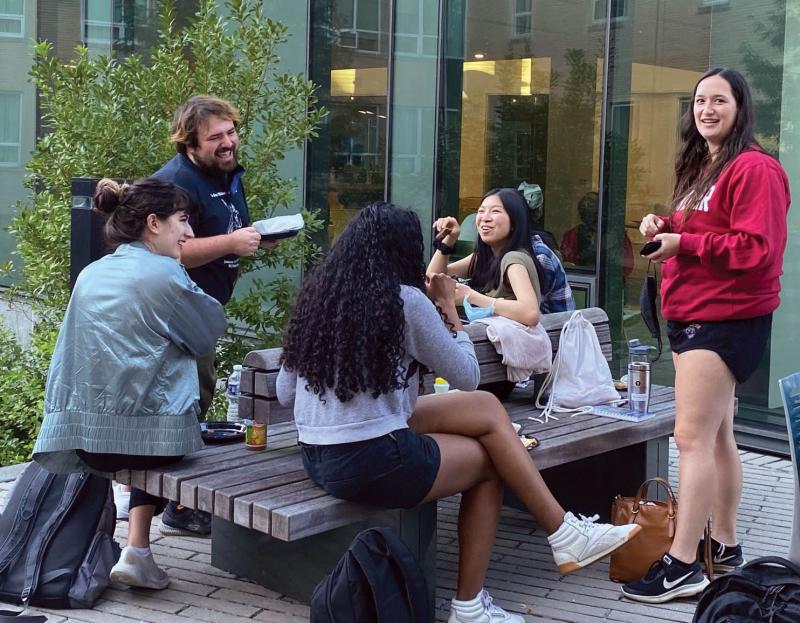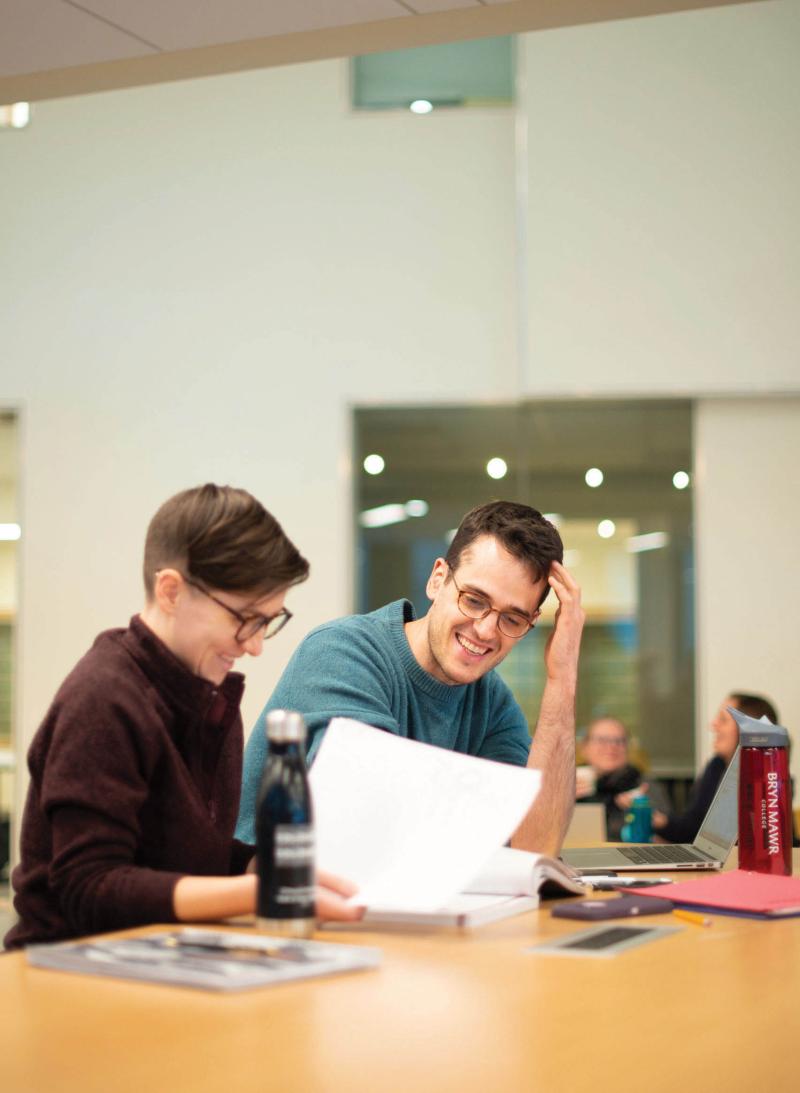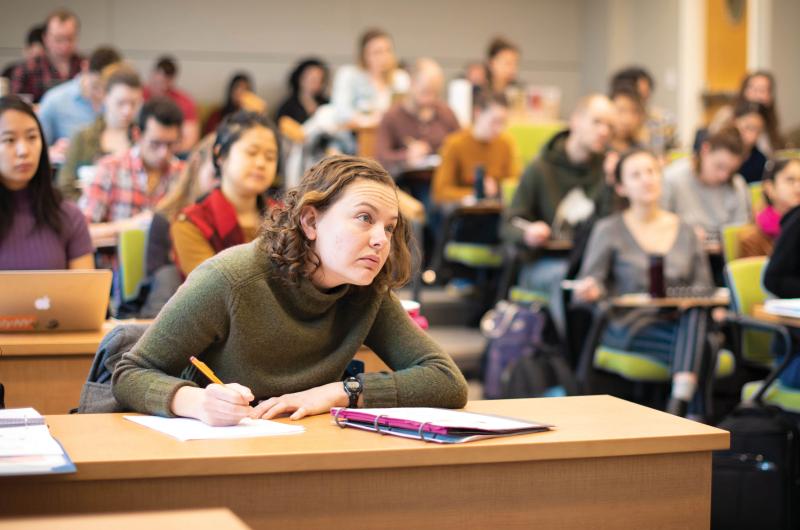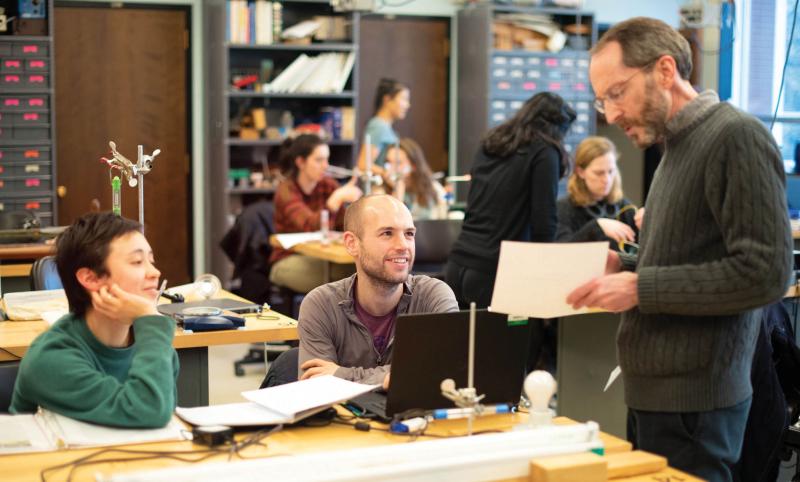¿¶∞Û«øºÈ‚Äôs Postbac Program at 50
¿¶∞Û«øºÈ's program for non-science majors drawn to medicine continues to change lives and impact healthcare.
Nathan Ashe decided to become a doctor when his fiancée became ill and he found himself spending time in the hospital every day. For Sophia Namara, the impetus was COVID and the racial justice protests that followed George Floyd’s murder. Brendan Carr heard the call while part of a crisis intervention team on the streets of Baltimore.
All three enrolled in ¿¶∞Û«øºÈ‚Äôs Postbaccalaureate Premedical Program. Their stories are typical of those who enter the program‚Äîwhich is to say, there is no such thing as a typical ¿¶∞Û«øºÈ postbac student.
A Postbac Primer
Google ‚Äúpostbac program‚Äù and you‚Äôll get literally thousands of responses. In general, explains Jodi Domsky, who directed ¿¶∞Û«øºÈ‚Äôs program from 1994 to 2014, there are three types of postbac programs: ‚ÄúOne for individuals historically underrepresented in medicine, one for candidates who need to boost their GPAs, and one for people who never took the prerequisites to apply to medical school and decided later on that they wanted to be a doctor.‚Äù ¿¶∞Û«øºÈ belongs to this last ‚Äúcareer changer‚Äù category, and, along with Columbia, was one of the first of its kind in the nation. ¿¶∞Û«øºÈ now has several peers, at schools such as Goucher, Penn, Scripps, Tufts, the University of Virginia, and Johns Hopkins, but remains one of the strongest and most respected postbac programs in the country.
The one-year intensive program gives students the introductory science requirements— general chemistry, organic chemistry, physics, and biology—they need to apply to medical school. “The students that we accept to our program might have one of those classes already completed, but usually not more than one,” Senior Lecturer in Biology Michelle Wien explains. The program also supports pre-vet and predental students, although the vast majority of enrollees are premed.
As well as equipping students with their science requirements, the program is known for its individual advising and for the “consort” agreements it has with 18 medical schools (and one dental school), through which students can complete the application process during their postbac year.
“I learn something every day from our students in terms of what they’ve done." — Program Director Glenn Cummings
The program started out small‚Äîwith eight students‚Äîin 1972, with ¿¶∞Û«øºÈ‚Äôs then-associate dean Patricia Pruett ‚Äô52, M.A. ‚Äô61, Ph.D. ‚Äô65, at the helm. Jodi Domsky took over the leadership in 1994, when she joined the College as associate dean and director of both the postbac program and the undergrad premed advising program. Domsky grew the program from around 40 postbacs to 75 before moving on to a position at Haverford College in 2015. Domsky also worked to bring more medical schools on board with consortial partnerships, and while she developed separate sections for undergrad and postbac classes, she also worked to integrate the two groups through labs, programming, and study groups. ‚ÄúWe wanted undergrads and postbacs to know each other, so we mixed the labs. I tried to find ways to give each the maximum benefits,‚Äù Domsky says.
Glenn Cummings, current director of the program, came to the College from health advising roles at the University of Virginia, Princeton, and Franklin & Marshall College, and, with a doctorate in English, he appreciates the diversity of backgrounds the ¿¶∞Û«øºÈ program attracts.
“I learn something every day from our students in terms of what they’ve done,” he says. “It’s really exciting to work with them. They have a very diverse background academically.”
Typically atypical
As wide-ranging as ¿¶∞Û«øºÈ postbac students‚Äô backgrounds are, they do share some things in common. They are older for one thing, often in their late 20s or even 30s, and have often had experience in the working world that is health related or perhaps have been patients themselves or had friends or family members who have been sick. ‚ÄúSo, they‚Äôve had sort of a front-row seat in healthcare,‚Äù Cummings says. ‚ÄúThey have a greater awareness of what it‚Äôs going to be like to be a caregiver in medicine and have thought long and hard about it.‚Äù
Jonathan Lascher, part of the current postbac cohort, worked as a leader at Partners in Health (PIH) in Sierra Leone before joining the program. With an undergraduate degree in international affairs, African studies, and peace studies, Lascher first considered going back to school to become a physician when he was a Peace Corps volunteer in Togo in 2006. “As I helped lead and grow PIH’s work in Sierra Leone, I never lost the thread of wanting to return to school one day to become a physician. If anything, I grew more and more drawn toward this path as my work allowed me to see that there are tangible ways to address the injustice of unequal access to quality healthcare.”
Cummings applauds the bravery of his students. “This is a big commitment,” he says. “Often when an undergrad says they want to be premed they get a lot of support from those around them, but for these guys, they don’t always get that resounding support. Instead, they get, ‘Aren’t you too old?’ ‘Why are you doing this?’ It takes courage to step forward.”
There is a lot at stake for them, agrees Domsky. “They drop their careers, they borrow a lot, they have to move to a new state,” she says.
Many, it turns out, are the children of doctors and other medical professionals. Michelle Wien explains it this way: “I think they start off feeling like, ‘Well, I’m not just going to automatically go and do what mom or dad was doing.’ And so that’s an additional impetus to explore some other interests, but then they realize, ‘When I compare the impact this career could have to what I see in my family member, wow, that’s a much bigger impact. That’s really attractive to me.’”
Wien has also taught veterans with experience as field medics, people who have worked as doulas and become interested in obstetrics, and “a steady supply” of students who have participated in Teach for America.
“I think the common thread is that most of us felt we weren’t science superstars but also felt we needed to be in healthcare." — Olivia Sheridan ('86)
Shahaan Razak (’17), a former Teach for America educator whose work took him to inner city schools in Philadelphia, Baltimore, and Camden, New Jersey, says lack of access to equitable healthcare became a staple in conversations with his colleagues and family. “Basic needs such as eye exams and dentist appointments were difficult for my students to access, much less mental health services or wellness initiatives,” Razak says. “It felt like a consistent uphill battle for students to have basic physiological needs met in order to be successful in the classroom. These experiences pushed me to consider a career transition.” Razak is now enrolled at Harvard Medical School.
¿¶∞Û«øºÈ postbacs also share an intense intellectual curiosity and sense of purpose. ‚ÄúThey have already reached their full academic potential in one field, went to wonderful places for their undergraduate education, did very well and had really interesting paths until they decided they wanted to be doctors,‚Äù says Domsky.
“Most of us had that unarticulated itch for a long time,” says Olivia Sheridan (’86), D.M.D., recently retired associate dean of admissions and clinician at Penn Dental. “I think the common thread is that most of us felt we weren’t science superstars but also felt we needed to be in healthcare. At a certain point, we thought, Well, I am smart, I am capable, why am I not at least exploring this.”
Brendan Carr (’97), M.D., M.S., now chair of emergency medicine at Mount Sinai Health System, sees something larger at play than merely the desire to be a doctor. “Most of us,” he says, “were feeling a draw toward something bigger than that. I think it was a draw toward delivering care for folks, taking care of folks, changing the healthcare delivery landscape.”
STEM Basics, With a Twist
Giving students with little science background all their STEM requirements for medical school in one year is a tall order, and the program is intense.
Nathan Ashe, a current postbac who has a Ph.D. in English, recalls how during orientation, “Glenn said, ‘It’s going to feel like a rollercoaster. Once you’re going, you’re going at 60 miles per hour.’ I thought at the time, Sure. You’re trying to get us a little overprepared, maybe freak us out a little bit so we’re ready. But he was not joking”
Sophia Namara, another student in this year’s program, says that coming back to the sciences after an eight-year interlude was “a bit of a jolt to the system.” She graduated from Bowdoin College with an undergraduate degree in French and visual arts and then worked at the Portland Museum of Art for several years. After getting a “terrible grade” on her first test, she was able to recover with support from her professors. “They want us to get to where we want to be,” she says. “Having that support was critical.”
For the first six months, remembers Sheridan, the future dentist who had majored in English and Latin as an undergraduate, “I cried every night. I sobbed. It was the hardest thing intellectually I’ve ever done in my life. I didn’t speak the language of science or math.” Again, her “incredible and humane teachers” came to the rescue. Plus, she says, “There were enough of us that were shell-shocked that we helped each other.”
Having only taken an introductory biology course as an undergraduate, Sara Taub (’07), M.D., M.B.E., found the experience intense. “I was very steeped in the academic part of the experience and sometimes felt like I was working day and night,” says Taub, now a pediatrician with Oregon Health & Science University in Portland, Oregon. “My husband would come visit from Chicago some weekends and basically fill my cupboards and fridge with groceries so that I could minimize interruptions for the next few weeks.”
“The postbacs are highly motivated. That is probably an understatement. They know exactly what they want to do, and they’re mature." — Assistant Professor of Chemistry Patrick Melvin
While the classes are similar to introductory classes at the undergraduate level, the faculty also make connections to the students’ future medical studies. Wien, for example, starts with a strong base of cell biology but builds up to showing how it affects the human body and human health. “So, we do first semester biology and finish a few weeks before the end of the semester,” she says, “because then we do big units on viruses and on cancer. That way they see how everything they’ve learned over the course of the semester applies to these really important biological and medical problems.”
In organic chemistry, explains Assistant Professor of Chemistry Patrick Melvin, the first semester covers exactly the same material as the undergraduate Organic 1 class, while Organic 2 has “more of the biochemistry and medically driven side, all in preparation for the MCAT.”
Melvin alternates between teaching undergraduates and postbacs and notices distinct differences between the groups. ‚ÄúThe postbacs are highly motivated,‚Äù he says. ‚ÄúThat is probably an understatement. They know exactly what they want to do, and they‚Äôre mature. That‚Äôs not to say that ¿¶∞Û«øºÈ undergraduates are not mature; of course they are. But there is a different level of maturity that comes with students who are maybe in their 30s and have worked and traveled a lot. They know how to navigate a class, and they are very forthcoming in what they need from me. It‚Äôs just a different level of engagement. For me it‚Äôs the best of both worlds.‚Äù
Taking the Fast Track
Through what’s known as the “consort process,” students can elect to apply to certain medical schools—those with an agreement with the program—while they are in the postbac program. The advantage to doing this, explains Wien, is that “you save a year, since applying to medical school is a whole-year process, and you can go to medical school directly after finishing the program. The downside is that you can apply to only one school, and it has to be on the list of schools the program has an agreement with.”
Around a half of each cohort opts for the consort route. Regardless of whether they choose that or not, every postbac student at ¿¶∞Û«øºÈ is guaranteed a committee letter, which provides a detailed account of their journey and describes their strengths in depth. For those who do not take advantage of the consort program and apply through the general application process, the program helps them get good gap-year jobs in medicine and medical research.
Good advice
One of the strengths of the program, say alums, lies in the close, individualized advising. ‚ÄúOur professors put in countless hours with us in the classroom, during office hours, and even after hours, responding to our emails and questions,‚Äù says Jonathan Lascher, the current postbac who worked in Sierra Leone. ‚ÄúPart of the mission of Partners in Health, where I was working before coming to ¿¶∞Û«øºÈ, is accompaniment. Glenn and the rest of the pre-health advising office are my ‚Äòaccompagnateurs.‚Äô‚Äù
Guidance is key, says program director Cummings, not just for helping his students succeed academically, but also for figuring out where they want to contribute to medicine. “No one’s expecting them to know that before they go to med school, but they can think about their values and how those might align with certain areas of medicine. Do I want to be in research? Do I want to be a clinician? Do I want to be in an urban or rural environment? Advising helps with that. Finding the right medical school and having success getting into that school takes some advising. There’s a right way to apply and a not-so-right way. If you go online and Google, you’ll get a lot of bad information.”
Connections that Count
“We worked really hard to create connections for the postbacs with each other, with the faculty, and with the directors,” says Domsky about her tenure leading the program. “We had social groups, medically related programming groups, and we connected them with volunteer experiences.”
Those elements are all still part of the program. Postbacs connect with ¿¶∞Û«øºÈ undergraduates in labs and study groups as well as outside of class through extra curricular health interest programming. Over the course of the year, undergrads and postbacs work together to organize a series of health-related events on topics such as global health, gender and health, surgery, and queer health. ‚ÄúWhatever students are interested in,‚Äù says Cummings.
Despite the academic pressures of the intense one-year program, postbac students find ways to bond and even relax. “It’s a very specific experience,” says Christopher Magoon (’13), M.D., a third-year psychiatry resident at Columbia University. “So having peers who are having a similar experience felt especially bonding. I remember some good laughs with study groups, basketball games with classmates, volunteering at a Chinatown free clinic, going on hikes in suburban PA, and blowing off steam at the gym.”
Jolene Kokroko (’13), M.D., M.P.H., now an obstetrician gynecologist in San Francisco, remembers how “we studied together, went to dinner together, and relied on each other during stressful academic times.” They even created food co-ops, “so that we only had to cook once a week for a group, and the other days, someone else provided lunch for you.”
Lasting Bonds
Though students are only in the postbac program for a year, their bonds often last much longer. ‚ÄúEven if they don‚Äôt go through the consort process,‚Äù Wien says, ‚Äústudents often end up going to those consort schools. And they know people who are already there. There‚Äôs a really big group of ¿¶∞Û«øºÈ postbacs, and they stay friendly once they‚Äôre there.‚Äù
And although they may come from very different backgrounds and be of different ages and identify in different ways, says Cummings, they have the same goal. “Lifetime friendships form,” he says. “I know of at least one former postbac who proposed to their partner in the Orgo lab. Their values are similar, and their challenges are similar. They go through the same transformation and come out the other end and go into the same profession.”
At Mount Sinai, Brendan Carr just offered a job to a former ¿¶∞Û«øºÈ postbac who is finishing her residency there. The associate medical director at Mount Sinai Hospital is Judah Sueker, another ¿¶∞Û«øºÈ postbac.
Sara Toub at Oregon Health & Science University says there have been many ‚Äúfunny intersections‚Äù over the years. ‚ÄúOne of my pediatrics co-residents and good friends at OHSU was married to a man who was in my ¿¶∞Û«øºÈ class and who did his internal medicine training at OHSU. We had no idea until we bumped into each other at our graduate medical education orientation! And the mother of one of my son‚Äôs best friends in preschool completed the ¿¶∞Û«øºÈ postbac a few years after me.‚Äù
Goals for the Future
When Cummings reflects on where the program is 50 years after its launch and what he hopes for its future, there are two areas that stand out as having room for growth.
“We mirror a lot of what is going on in medical school,” he says. “I’d love it if in coming years we’d continue to have a student body that better reflected the patient populations these people in training are going to care for. We’re not as diverse as we could be. So that’s a goal we’re working on.”
Cummings also wants to see the alumni network continue to grow. ‚ÄúWe have people now at the pinnacle of their medical career that did this program, as well as people who have retired,‚Äù he says. ‚ÄúBeing able to build a greater connection to that population is important to us, for mentoring and enriching the experience of our students and alums, because ¿¶∞Û«øºÈ postbacs are in all areas of medicine, and they‚Äôre out in the world doing amazing things. When you think about all the people who have done this program, we‚Äôve had
a substantial impact on medical education.”





